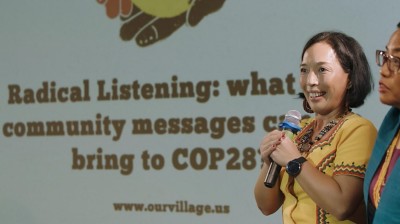Artivism
Transcript
- I like to call myself an artivist because I like to combine my activism with my art.
- I think artivism is so important in this movement.
- When you think back to the ’60s and the civil rights movement, music in itself, just alone, just music alone was just,
- you can still hear and feel the energy from that time in the music if you listen to it today.
- And so I think artivism is so important, whether it’s spoken word, whether it’s film, television, projects, whether it’s an actual piece of artwork or a beautiful song, art touches people, art moves people.
- We’re talking about what is climate justice.
- I think for sure, it’s focussing on the people who were affected first and worse.
- I think the narrative in the media is still a little bit too much about polar bears and ice glaciers.
- I’m from New Jersey. I never seen a polar bear.
- So, you know, I think it’s really important that not only is the narrative focussed on those people that are being affected by the pollution that’s causing the climate to change.
- I mean, they’re being sickened and killed as we speak by the pollution that’s causing climate change. And so that’s an issue that needs to be really focussed on.
Art has the power to reach and engage people on an emotional level, transcending language barriers and stimulating dialogue. Artivism is a term that combines art and activism, referring to artistic activities or practices that aim to bring about social, political, or environmental change. It is a form of creative expression that merges artistic skills and techniques with a message or cause, intending to raise awareness, challenge norms, or inspire action. Artivists use various art forms such as visual arts, performance art, music, theater, literature, film, graffiti, and more to communicate their ideas and advocate for social justice, human rights, environmental sustainability, and other pressing issues. Artivism has gained prominence in recent years as artists and activists recognize the potential of art to amplify their messages and engage diverse audiences. It serves as a powerful tool for social transformation, encouraging critical thinking, empathy, and collective action. By blending art and activism, artivists aim to go beyond simply raising awareness. They seek to challenge the status quo, question dominant narratives, and inspire positive change in society. Through their creative expressions, they often confront power structures, inequality, discrimination, and systemic issues, ultimately aiming to create a more inclusive, equitable, and sustainable world.

What is climate justice?
The systems of oppression that we all live in right now are based in domination and they are all interconnected. Only by tackling the systemic violence that is embodied in capitalism, racism, sexism and others can we truly fight the climate crisis


